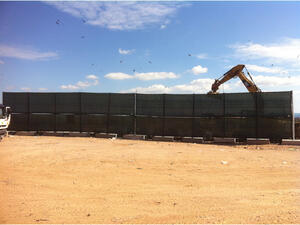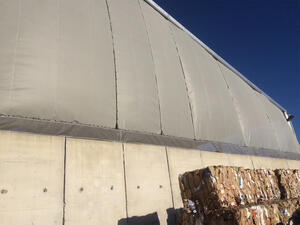How to choose a windbreak?
 |
Our advice for choosing a windbreakWaste stored at treatment sites can be exposed to wind and weather. To prevent any risk of waste being carried outside the facility, many companies opt for suitable protection. Windbreaks are often chosen for this purpose because they are designed to withstand outdoor conditions. These are nets with tight mesh that can reduce or halt the effects of the wind. OTEXIO helps you choose the windbreak that suits your situation. |
What are the characteristics of windbreaks?
There are different types of windbreaks, each with their own properties and qualities: fast-growing plants, fencing, wire mesh, and more. We present you with the key information you need to know about windbreaks and their installation.
Materials of the windbreak
Windbreaks can be made from various materials, valued for their aesthetic appearance and resilience. Hedges provide a natural look and effective protection against strong winds, provided you choose suitable species, such as evergreen varieties. Windbreaks with a natural appearance are also effective in reducing air currents, such as bamboo or heather reed screens. Fabric nets and fabrics with varying degrees of tight mesh are often a more durable solution in terms of both protection and visual appearance.
Height of the net
The shape and dimensions of the net directly affect the areas protected by it. Hence, the height of the windbreak is an important criterion to consider when making your choice. It is generally accepted that a net of a certain height protects an area with a width that is 10 times this height. Thus, it depends on the width of the area you want to shield from the wind. The slope of the terrain should also be taken into consideration as it modifies the windbreak's effective zone.
Length of the net
Similar to the height, the length of the net also has a direct influence on the size of the protected areas. To ensure optimal protection, it's important to choose appropriate sizes. For this, we recommend installing windbreaks with a length that is at least 10 times the height of the net. This way, the area behind the net will be optimally sheltered across its entire surface.
Porosity of the net
Porosity refers to the empty spaces between the mesh of the net. Depending on the porosity level of the material, the windbreak net doesn't provide the same protection. An impermeable net almost completely blocks the wind as well as some adverse weather effects over a reduced surface, causing possible turbulence beyond the protected zone. A permeable net, on the other hand, offers overall less resistance. It only blocks some of the wind but over a much larger surface without generating swirls or air currents. Although it doesn't shield from rain, it's often the preferred type of net.
Criteria to consider when choosing your windbreak
Take the time to accurately estimate the total surface area of the outdoor space to protect. With this value, you can easily determine the length of fabric or windbreak net you need. With the width of the area you want to shield from the wind, you can deduce the necessary panel height to optimally block the wind.
The nature of the terrain is also an important criterion. If it's sloped, the area to protect is larger, so you need to adjust the windbreak dimensions accordingly.
If you plan an opening on the same side as your net, it must be correctly positioned. An opening can indeed create turbulence, so the choice of its location is crucial to maintain the net's effectiveness.
Also, take into account the strength and direction of the winds. With this data, you can then determine the best location for your windbreak, as well as its porosity. OTEXIO accompanies you in your project, from study to installation.
You now know how to make an informed choice when selecting your windbreak.
